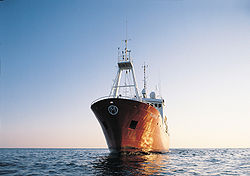
MS Polarfront
Encyclopedia

Weather ship
A weather ship was a ship stationed in the ocean as a platform for surface and upper air meteorological observations for use in weather forecasting. They were primarily located in the north Atlantic and north Pacific oceans, reporting via radio...
located in the North Atlantic. She was the last remaining weather ship in the world, maintained by the Norwegian Meteorological Institute
Norwegian Meteorological Institute
Norwegian Meteorological Institute is the Norwegian national institute for weather forecasts.The three main offices are located in Oslo, Bergen and Tromsø. The Institute has around 500 employees and keeps around 650 paid observers of various kinds around the country...
.
A weather ship is a ship
Ship
Since the end of the age of sail a ship has been any large buoyant marine vessel. Ships are generally distinguished from boats based on size and cargo or passenger capacity. Ships are used on lakes, seas, and rivers for a variety of activities, such as the transport of people or goods, fishing,...
stationed in mid-ocean
Ocean
An ocean is a major body of saline water, and a principal component of the hydrosphere. Approximately 71% of the Earth's surface is covered by ocean, a continuous body of water that is customarily divided into several principal oceans and smaller seas.More than half of this area is over 3,000...
to make meteorological observations for weather forecasting
Weather forecasting
Weather forecasting is the application of science and technology to predict the state of the atmosphere for a given location. Human beings have attempted to predict the weather informally for millennia, and formally since the nineteenth century...
. Since the 1960s this role has been largely superseded by satellite
Satellite
In the context of spaceflight, a satellite is an object which has been placed into orbit by human endeavour. Such objects are sometimes called artificial satellites to distinguish them from natural satellites such as the Moon....
s, long range aircraft
Aircraft
An aircraft is a vehicle that is able to fly by gaining support from the air, or, in general, the atmosphere of a planet. An aircraft counters the force of gravity by using either static lift or by using the dynamic lift of an airfoil, or in a few cases the downward thrust from jet engines.Although...
and weather buoy
Weather buoy
Weather buoys are instruments which collect weather and ocean data within the world's oceans, as well as aiding during emergency response to chemical spills, legal proceedings, and engineering design. Moored buoys have been in used since 1951, while drifting buoys have been used since 1979...
s.
MS Polarfront was known as the weather station M ("Mike"), and was located at 66°N, 02°E. Standard meteorological observations were performed on an hourly basis since the beginning of the 1960s.
On February 27, 2009, the cancellation of the station was announced. MS Polarfront was removed from service January 1, 2010.
History of Station M
The International Civil Aviation OrganizationInternational Civil Aviation Organization
The International Civil Aviation Organization , pronounced , , is a specialized agency of the United Nations. It codifies the principles and techniques of international air navigation and fosters the planning and development of international air transport to ensure safe and orderly growth...
(ICAO) took the responsibility to operate an international network of Ocean Weather Stations in The North-Atlantic. The network was established in 1948 and consisted of 13 stations. Station ‘M’ (Mike) was one of these. The need for weather ships from civil aviation decreased gradually while the Meteorological society still needed the observations from the oceans. In 1974 the World Meteorological Organization
World Meteorological Organization
The World Meteorological Organization is an intergovernmental organization with a membership of 189 Member States and Territories. It originated from the International Meteorological Organization , which was founded in 1873...
(WMO) took the responsibility for the four remaining stations. The international agreement about weather ships was ended in 1990. Great Britain and Norway continued the operation of one station each, Lima West of Scotland and Mike in the Norwegian Sea. Lima was ended in the middle of the 1990s. Thus Mike is the only one still remaining.
The first two weather ships to man station “M” were Polarfront I and Polarfront II. The Norwegian authorities were the ship owners. The ships were rebuilt Royal Navy
Royal Navy
The Royal Navy is the naval warfare service branch of the British Armed Forces. Founded in the 16th century, it is the oldest service branch and is known as the Senior Service...
corvette
Corvette
A corvette is a small, maneuverable, lightly armed warship, originally smaller than a frigate and larger than a coastal patrol craft or fast attack craft , although many recent designs resemble frigates in size and role...
s ( and ). They were on duty until 1974 and 1976. In 1974 the Norwegian state made an agreement with the shipping company Misje Offshore Marine AS in Bergen
Bergen
Bergen is the second largest city in Norway with a population of as of , . Bergen is the administrative centre of Hordaland county. Greater Bergen or Bergen Metropolitan Area as defined by Statistics Norway, has a population of as of , ....
to hire a new and modern ship, which was given the name Polarfront.
For several years the ship alternated with the Dutch weather ship Cumulus to man station ‘M’. In 1986 and onward Polarfront has manned station ‘M’ alone. Each month Polarfront leaves the station for 1-2 days to take on a new crew and new supplies. Once a year, usually in the beginning of October, the ship will stay in her home port for a week to carry out maintenance.

